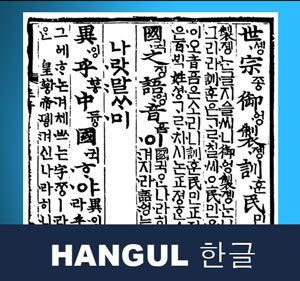Taekwondo 태권도Taekwondo Preschool
Promotion from one geup to the next can proceed rapidly in some schools, since schools often allow geup promotions every two, three, or four months. Students of geup rank learn the most basic techniques first, and then move on to more advanced techniques as they approach first dan. Many of the older and more traditional schools often take longer to allow students to test for higher ranks than newer, more contemporary schools, as they may not have the required testing intervals. View Taekwondo belt levels »

Letter Names ( 한글 hangul )
Hangul is a featural alphabet of 24 consonant and vowel letters. However, instead of being written sequentially like the letters of the Latin alphabet, Hangul letters are grouped into blocks, such as 한 han, each of which transcribes a syllable.
The hangul arrangement is called the ganada order, (가나다 순) which is basically an alphabetical order named after the first three letters (g, n, d) affixed to the first vowel (a). The letters were named by Choe Sejin in 1527. North Korea regularized the names when it made Hangul its official orthography.
Consonant Names
The modern consonants have two-syllable names, with the consonant coming both at the beginning and end of the name, as follows:
| Consonant | Name |
|---|---|
| ㄱ | giyeok (기역), or kiŭk (기윽) in North Korea |
| ㄴ | nieun/niŭn (니은) |
| ㄷ | digeut (디귿), or tiŭt (디읃) in North Korea |
| ㄹ | rieul/riŭl (리을) |
| ㅁ | mieum/miŭm (미음) |
| ㅂ | bieup/piŭp (비읍) |
| ㅅ | siot (시옷), or siŭt (시읏) in North Korea |
| ㅇ | ieung/iŭng (이응) |
| ㅈ | jieut/chiŭt (지읒) |
| ㅊ | chieut/ch'iŭt (치읓) |
| ㅋ | kieuk/k'iŭk (키읔) |
| ㅌ | tieut/t'iŭt (티읕) |
| ㅍ | pieup/p'iŭp (피읖) |
| ㅎ | hieut/hiŭt (히읗) |
All consonants in North Korea, and all but three in the more traditional nomenclature used in South Korea, have names of the format of letter + i + eu + letter. For example, Choi wrote bieup with the hanja 非 bi 邑 eup. The names of g, d, and s are exceptions because there were no hanja for euk, eut, and eus. 役 yeok is used in place of euk. Since there is no hanja that ends in t or s, Choi chose two hanja to be read in their Korean gloss, 末 kkeut "end" and 衣 ot "clothes".
Originally, Choi gave j, ch, k, t, p, and h the irregular one-syllable names of ji, chi, ki, ti, pi, and hi, because they should not be used as final consonants, as specified in Hunmin jeong-eum. But after the establishment of the new orthography in 1933, which allowed all consonants to be used as finals, the names were changed to the present forms.
The double consonants are named with the word 쌍/雙 ssang, meaning "twin" or "double", or with 된 doen in North Korea, meaning "strong". Thus:
| Letter | South Korean Name | North Korean name |
|---|---|---|
| ㄲ | ssanggiyeok (쌍기역) | toen'giŭk (된기윽) |
| ㄸ | ssangdigeut (쌍디귿) | toendiŭt (된디읃) |
| ㅃ | ssangbieup (쌍비읍) | toenbiŭp (된비읍) |
| ㅆ | ssangsiot (쌍시옷) | toensiŭt (된시읏) |
| ㅉ | ssangjieut (쌍지읒) | toenjiŭt (된지읒) |
In North Korea, an alternate way to refer to a consonant is by the name letter + ŭ (ㅡ), for example, 그 kŭ for the letter ㄱ, 쓰 ssŭ for the letter ㅆ, etc.
Vowel Names
The names of the vowel letters are simply the vowel itself, written with the null initial ㅇ ieung and the vowel being named. Thus:
| Letter | Name | Letter | Name |
|---|---|---|---|
| ㅏ | a (아) | ㅐ | ae (애) |
| ㅑ | ya (야) | ㅒ | yae (얘) |
| ㅓ | eo (어) | ㅔ | e (에) |
| ㅕ | yeo (여) | ㅖ | ye (예) |
| ㅗ | o (오) | ㅘ | wa (와) |
| ㅛ | yo (요) | ㅙ | wae (왜) |
| ㅚ | oe (외) | ||
| ㅜ | u (우) | ㅝ | wo (워) |
| ㅠ | yu (유) | ㅞ | we (웨) |
| ㅟ | wi (위) | ||
| ㅡ | eu (으) | ㅢ | ui (의) |
| ㅣ | i (이) |
In the Seoul dialect of Modern Korean, e(ㅔ) and ae(ㅐ) have no distinction in pronunciation. For this reason they are denoted as eo-i(어-이) for e(ㅔ) and a-i(아-이) for ae(ㅐ) when giving the spelling of a word or name in spoken conversation.
Related Articles
Taekwondo Basics
Here is where you can learn more about Taekwondo 태권도. Knowing the fundamental basics is very important for your learning path as you build your skills and knowledge. There are certain rules that need to be followed to show respect to the master ( 사범님 sabeomnim ), the instructors ( 교사님 gyosannim ), other practitioners and to the martial arts. They vary between schools but many have similar rules and guidelines. For more information View Taekwondo Basics »
There are five tenets defined in the International Taekwondo Federation (ITF) and several more in World Taekwondo (WT).
Perseverance ( 인내 in-nae ): "One will persevere time and time again until they have achieved a result which is adequate towards what one was trying to achieve." View Taekwondo Tenets »
RESOURCES
This article uses material from the Wikipedia article "Hangul" which is released under the Creative Commons Attribution-Share-Alike License 3.0.










